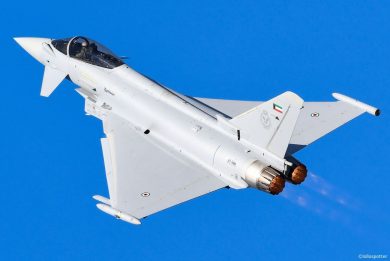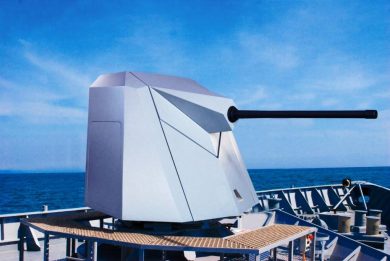Leonardo unveils its new 120 mm L55 tank gun
Less than one month after the first firings, Leonardo unveiled to a selected group of media its new 120 mm L55 tank gun. The event took place at the “Cottrau” gunnery test range, close to La Spezia, part of the Italian Navy Naval Experimentation Support Centre (CSSN), and included a further six-round firing test
“Today we will focus on the 120 mm,” Luca Perazzo, deputy Managing Director at Leonardo Electronics Defence Business Area announced in his opening remarks, the event being aimed not only at showing for the first time the new 55-calibre gun, but also a new ammunition that will be described in a following article.
In the recent past Leonardo heavily invested in new machinery to increase the barrel production capacity of its La Spezia facility. “Our target is to have a production capacity of 800 barrels per year, half of them medium calibre, the remaining half being bigger calibres both for land and naval use,” Perazzo said, adding that “in 2024 we produced 170 barrels, while in 2025 we aim at producing 260 barrels.” EDR On-Line understood that two new autofrettaging machines were acquired to cope with the target production rate, replacing the single one existing in the past. In recent times the site hired 300 manpower, 40% of them in the mechanical department, which is currently working on two shifts, the breech production section working on three shifts to ensure a sufficient output to match that of the other sections.
“The 120 mm L55 project was fully developed on company funds,” Perazzo underlined, adding that this gun is aimed only at tracked vehicles, as it cannot be adopted on wheeled platforms due to the recoil. He then left the floor to Manuel D’Eusebio, the Head of Mechanical Design Land systems and Artillery, who detailed the programme.
“It took only 18 months from the first presentation to the customer to the first firing, which included the design phase, the production of the first prototype, and testing,” D’Eusebio underlined, adding that “The first firings took place on June 24th, 2025, at the Italian Army Land Armaments Technical Territorial Office in Nettuno, close to Rome, and included a six-round session.”
The new gun is heavily based on the experience gained by then Oto Melara in the 1980s, when the company developed the 120 mm L44 smoothbore gun for the Ariete main battle tank (MBT), and in the early 2000 when then Leonardo developed an improved version, the 120 mm L45 gun, installed on the Centauro II armoured car.
“The new gun was designed considering the design pressure of the latest developments in the ammunition field, especially APFSDS ones, which will allow a significant increase in performances,” such rounds being for example Rheinmetall’s KE2020Neo, also known as eKE, for enhanced Kinetic Energy.
While from the performances standpoint the new gun is a new weapon, it is heavily based on the two previous products, the newest element being the longer barrel, other key sub-assemblies being also subject to modifications to withstand the higher stress and the heavier barrel mass being the breech block and the recoil brake/recuperator assembly. Beside the typical study path that includes Finite Element Method analysis, ballistic study and thermal analysis, EDR On-Line understood that software-based simulation systems were used and considerably helped in reducing development time, allowing to mimic the firing phase in different conditions.
The two hydraulic cylinders of the recoil brake were redesigned to cope with the higher recoil, the new oil-gas accumulator cylinder allowing compensating oil level variations inside the elastic components. Both the new breech block and the recoil brake system are fully compatible with the exiting gun installed on the Ariete and on HITFACT II turrets.
Switching to the barrel, this is made of the same steel alloy used for the 120 mm L45 gun of the Centauro II, however Leonardo improved the autofrettaging process which allows to considerably increase the design pressure, a new geometry being also adopted for the barrel. The company stated that the design pressure is higher compared to current competitors, hence a greater growth potential. A generic indication, 1,200 rounds, was given for the forecasted barrel life, EDR On-Line understanding that this is considered the average for 120 mm barrels and that the real number is not being revealed for the time being, barrel wear depending however very much on the type of ammunition used, APFSDS typically having a higher wear rate compared to “slower” ammo.
The Leonardo 120 mm L55 thermal sleeve is subdivided in four main elements; starting from the muzzle, the sleeve between the muzzle and the bore evacuator is made of composite and aluminium, the bore evacuator itself is also a hybrid composite/aluminium assembly, the latter materiel ensuring resistance to corrosion and high temperatures, the element between the bore evacuator and the interface between the cradle and the barrel is also made of composite and aluminium, the latter protecting composite materiel when the barrel slides back into the interface during firing, recoil stroke being around 550 mm, similar to that of the L45 gun, and finally the interface is all composite.
Compared to the 120mm L45 gun barrel the mass of the L55 barrel is around 500 kg higher, while muzzle velocity is increased by around 5%.
One of the requirements that Leonardo set since the very beginning of the design process was to have maximum modularity of the barrel, to be able to install it in pre-existing systems, potentially providing increased performance. Of course the 120 mm L55 can fire all existing NATO standard 120 mm, including airburst ones, the latter needing a programming system.
Before the first firing Leonardo performed all required tests, and developed a system that allows to realistically perform the entire kinematics and dynamics of opening, closing the breech, move the barrel backwards, ejecting the stub case, and bringing the barrel back to the rest position. A “field” version could be seen on the prototype ready to fire at the Navy test range.
On June 24th, 2035, the fourth firing was done using an overpressure round, followed by two more firings in order to relax the barrel. The new gun prototype was then brought back to La Spezia where it was completely disassembled and all elements underwent non-destructive checks, magnetic resonance, ultrasound resonance and dimensional imaging. It is to note that this is standard procedure for every single barrel produced by Leonardo.
While in the past all tests for land platform guns were conducted at the Nettuno facility, the La Spezia range being used for naval guns, recently the Italian Army agreed that tests can also be done at the Navy facility, which is much closer to the company, a few kilometres compared to over 450 km. This will considerably help in view of high numbers of guns to be tested, considering the production of over 1,000 tracked platforms for the Army in the coming decade, most of them armed with medium or heavy calibre guns.
Visiting the firing setup allowed to observe that the gun was positioned pretty close to the tunnel where shots would fall. The 36 metres distance ensures that when using discarding sabot ammunition, the sabot opens up when the round is already in the tunnel, maximising safety. During the demonstration, which highlighted the considerable stability of the gun, six rounds were fired, alternating one DM88 KE target practice round and one DM98 HE full calibre target practice ammunition, both produced by Rheinmetall.
Of course Leonardo aims to install its new 120 mm L55 on the i-MBT, the Italian Army future MBT that is being developed by LRMV, the joint venture between the Italian group and Rheinmetall of Germany. During a presentation of the Lynx IFV that took place in February this year, a workshare on 120 mm barrels was announced, Italy being in charge of producing them for 82 tanks while Germany would provide those for the remaining 50, to which we must add around 50% of spare barrels. This split remains valid, EDR On-Line was told, the two systems having the same characteristics, the only difference being that the Italian production will not be anymore under German license.
The new oscillating mass might also be installed on the Ariete, the first tank in the C-2 upgraded version being very close to be delivered to the Italian Army. Nothing is yet established, but this would clearly considerably improve the Ariete lethality. It will certainly require some modification on the turret, mostly on electric actuators that will need to be replaced by more powerful ones especially for elevation, considering the increased mass of the barrel and the centre of gravity moved forward. Italy is also considering a scout version of the AICS, the working name of the future Italian Army infantry fighting vehicle, based on Rheinmetall’s Lynx KF41.
For the time being the one seen at the La Spezia test range is the only example existing; however five more are in production. “Five will be used for testing,” Manuel D’Eusebio explained, while the company counts that the sixth will already find its place on board a platform. The qualification process should last 12 months, if not less, Leonardo being in discussion with the military on the testing procedure, as many components were already qualified with the previous gun versions. The 120 mm L55 gun is currently considered at TRL 6, qualification being forecasted for Q3/2026.
Graphics courtesy Leonardo, photos courtesy Leonardo and P. Valpolini











